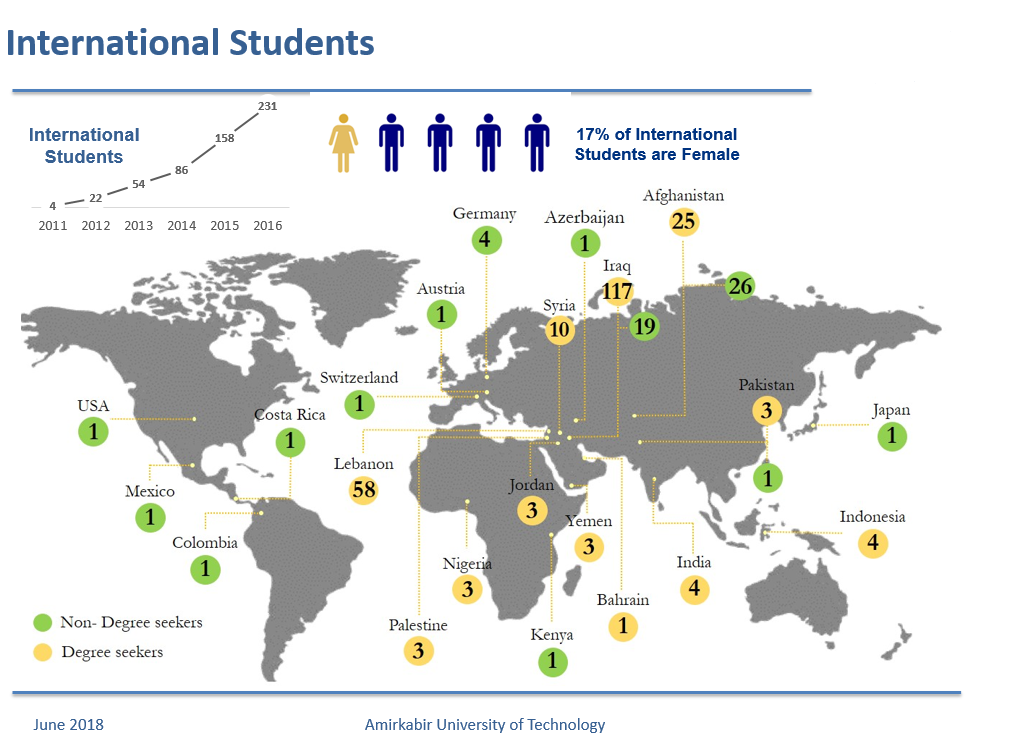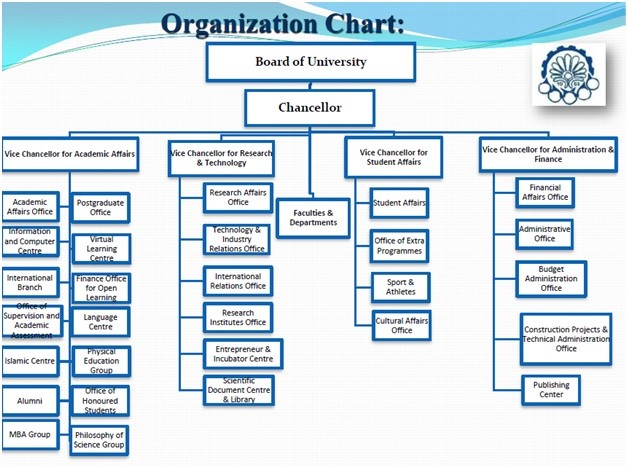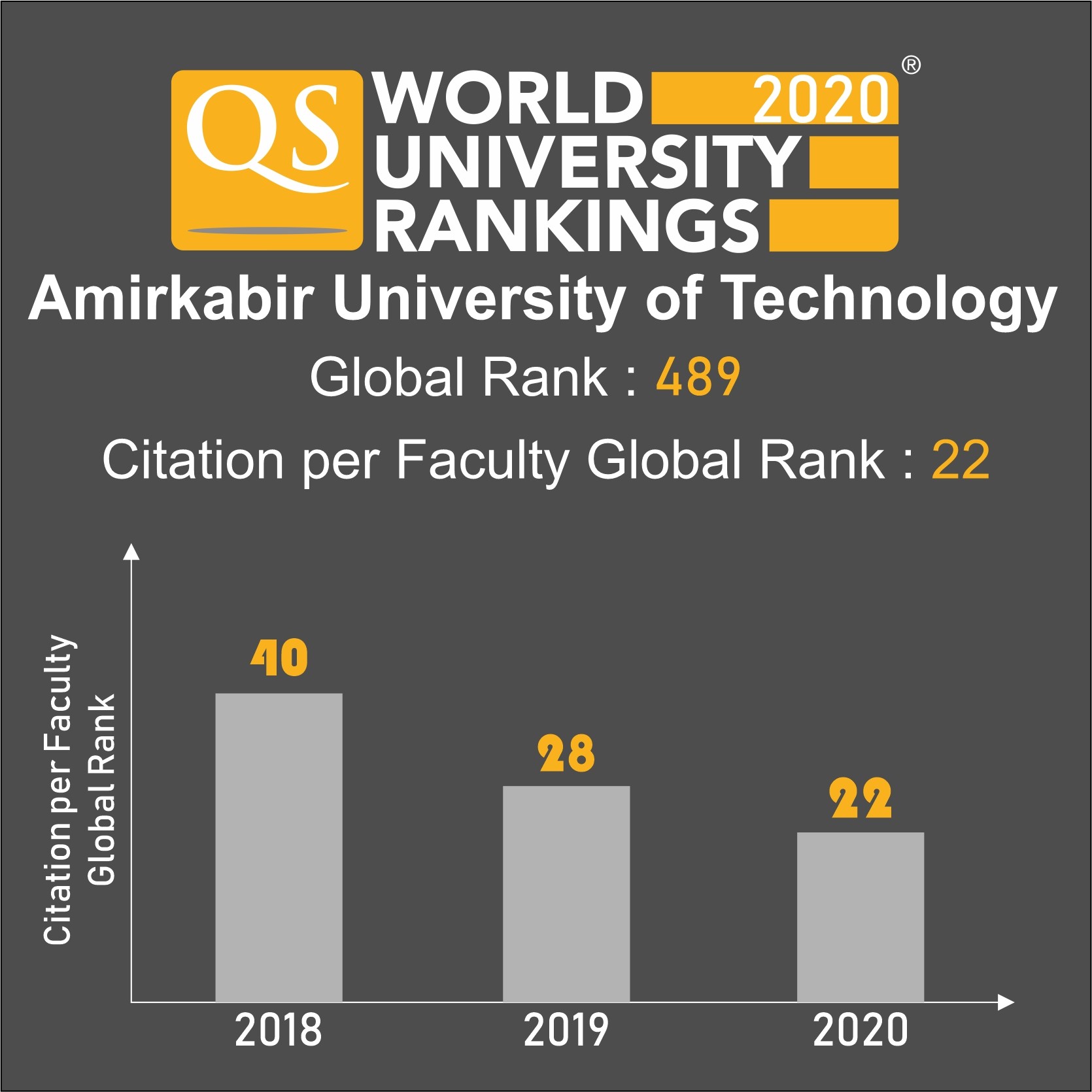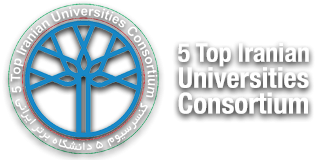Amirkabir University of Technology
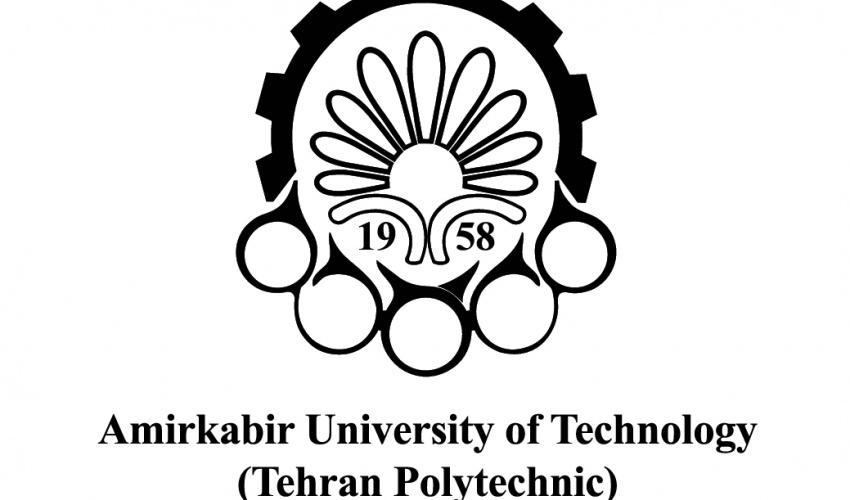
Amirkabir University of Technology (AUT) is among the oldest and most prestigious of higher education technical and engineering institutes in Iran. AUT’s lengthy history of success has flourished even more significantly, after the Islamic Revolution in Iran. Amirkabir University has continuously offered distinguished services and contributed to the achievement of numerous educational and research goals.
AUT is located in the central part of Tehran, giving students the benefit of being close to the city’s many historical sites, cultural attractions and events. From museums, theaters, concert halls and art galleries, to ski resorts, local cafes and lively restaurants with, Tehran has much to offer those who wish for a vibrant and memorable student life.
AUT students experience a myriad of social, cultural, educational, and recreational activities and events during their academic life. They are provided with health services, housing and dining services, as well as recreational facilities and spaces. Students are invited to participate in their choice of the many student associations and groups with which they may share their personal passions and connect with other students. From poetry and movie clubs to astronomy and religious clubs, each student can find his/her interest and experience a dynamic life at AUT.
Besides AUT’s presidents, the expansion and honor of Amirkabir University of Technology in all scientific and industrial realms is due to the attempts and contributions of officials, professors, deans, alumni, staff, and students who have each had their share in elevating AUT’s academic level in achieving its greatness. During the Islamic Revolution, Tehran Polytechnic was an active student hub and played an active role in its victory. After the Islamic Revolution, Tehran Polytechnic became a university in 1979 and was named Amirkabir University of Technology in memory of Amirkabir Farahani, an outstanding figure in Iran’s contemporary history who had resolved to expand and develop the pillars of technology and industry in Iran. In order to comply with the cultural and scientific policies of the new sovereignty, AUT underwent major changes in its organization which include: Faculty for Training Teachers of Science and Technology was separated from AUT due to the overlap of its mission with Teacher Training Centers and was annexed to the teacher training academic system. The Higher School of Civil Construction was separated from AUT and was annexed to a complex named Khaje Nasir-e-Din Toosi University. Establishment of new faculties and courses especially at the graduate level which led to the establishment of six new faculties in the span of 1989 to 1996.
The initial establishment and formation of AUT dates back to October 1956. The initial core of the university was, then, formed under the name Tehran Polytechnic in order to expand the activities of two technical institutions of the time: Civil Engineering Institute and The Higher Art Center. The first group of students were admitted in 1957 through an internal exam and AUT officially commenced its activities in 1958, with five engineering majors: Electronics and Electrical, Mechanical, Textile, Chemistry and Civil Engineering.
Along with the gradual expansion of the university up to 1978, the following five sectors were also added:
Faculty of Technology: This faculty constituted the core of Tehran Polytechnic and incorporated 6 institutes or educational departments, namely, Electronics and Electrical Engineering, Chemical and Petrochemical Engineering, Polymer and Textile Engineering, Mechanical Engineering, Mining Engineering and Industrial Engineering.
Faculty for Training Teachers of Science and Technology was formed in 1955 in collaboration with the Ministry of Education.
Faculty of Basic and Computer Sciences: This faculty was established in order to offer courses to students of other majors and the courses taught were non-degree.
Institute of Graduate Studies and Research: This institute was established in order to administer the MSc programs and the university’s research affairs. At the time, this institute used to manage 5 MSc programs and the Center for Research in Food Industries.
From 1977 onward, administration of the Higher School of Civil Construction was left to Tehran Polytechnic and, in this way, this unit was annexed to AUT as the fifth sector.
After Mr. Habib Nafisi, the founder of Tehran’s Polytechnic, Dr. Abedi replaced him for a few months as the president of Polytechnic. Then by 1963, Dr. Mojtahedi, the former headmaster of Alborz High School, was appointed as the president of Polytechnic. Dr. Mojtahedi performed a lot of services for Polytechnic, and one can say that Polytechnic owes its honor and fame to him. It should be noted that the services of Mr. Nafisi in the establishment of Tehran’s Polytechnic with all its difficulties, as well as the efforts of Dr. Mohammad Ali Mojtahedi in raising the scientific level of the university in its early years has been of particular importance.
In addition to raising the scientific level of the university, Dr. Mojtahedi, constructed a central amphitheater, dining hall and finished the establishment of various departments. He who had received his Ph.D. in mathematics from France, after being appointed as the head of Polytechnic University; in addition to making changes in the faculty members of this university, established an amphitheater, restaurant, sports field and equipped laboratories and established a special order in the university. After completing his three-year term in 1966, he founded a new university that was later named Sharif University of Technology.
After Dr. Mojtahedi, Dr. Bina was the president of Polytechnic University for about a year and a half. In 1967 Mr. Nafisi who had returned from the United States, was reappointed to the presidency of Polytechnic University again. One of the steps he took in his reelection for Polytechnic, was to prepare a coherent history of the university. This work was carried out by a couple of UNESCO engineers who had been invited by Mr. Nafisi to complete this project.
Here is a list of the other presidents of AUT:
-
Dr. Yeganeh Haeri, the first PhD in Metallurgical Engineering in Iran (1967 – )
-
Dr. Mohammad Jafar Jad Babaei, PhD in Chemical Engineering .
-
Dr. Kazem Najmabadi .
-
Dr. Hussein Maheban, PhD in Mechanical Engineering .
-
Dr. Sirous Shafeai, PhD in Mining Engineering.
-
Dr. Miri from Tehran University of Technology, from .. for a few months.
-
Dr. Mehdi, a faculty member of the Electrical Engineering department, from … to the victory of the Islamic revolution.
-
Dr. Hassan Farid Alam, a faculty member of the Industrial Engineering department, for a few months after the victory of the Islamic revolution.
-
Dr. Seyed Kamalodin Nikravesh, PhD in Electrical Engineering.
-
Dr. Hassan Rahimzadeh, PhD in Mechanical Engineering .
-
Dr. Aliakbar Ramezanianpour, PhD in Civil Engineering .
-
Dr. Reza Husseini Abardeh, PhD in Mechanical Engieering.
-
Dr. Mohammad Hussein Salimi Namin, PhD in Industrial Engineering.
-
Dr. Alireza Rahaei, a faculty member of Civil Engineering department .
-
Dr. Abdulhamid Riazi, a faculty member of Mathematics .
-
Dr. Seyed Ahmad Fahimifar, a faculty member of Civil Engineering department .
-
Dr. Alireza Rahaei, a faculty member of Civil Engineering department .
-
Dr. Seyed Ahmad Motamedi, a faculty member of Electrical Engineering department
AUT Facts and Figures
Post date: 2019/05/8
-
opened:1958
-
Student Enrollment:
-
Undergraduates:5,345
-
Graduates :8,239
-
-
Faculty:
-
110 Professors
-
526(total staff)
-
10 Minister post
-
-
Research (in 2015):
-
3495 journal papers
-
1317 ISI Papers
-
205 bilion Rials industrial project
-
63 patents
-
16 mega projects
-
-
70 MOUs from 24 Countries 4 Continents
-
Between 150 -200 Technological Universities (shanghai Academic Ranking 2015)
-
Four campuses around Iran
-
Tehran
-
Garmsar
-
Mahshahr
-
Bandar Abbas
-
-
19 differnet Departments
-
16 Centers of Excellence
-
24 Research Centers and Institutes
